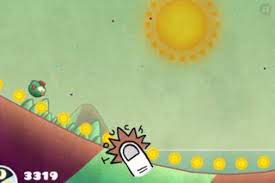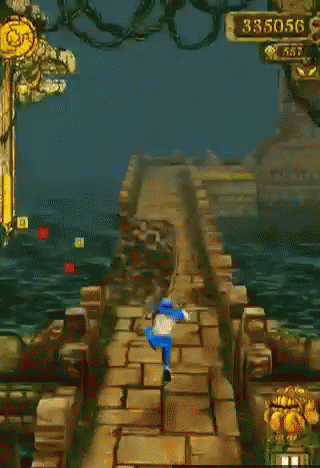For this assignment, I explored two games with a similar concept but vastly different themes, to see how different themes impacted the overall gameplay, as well as help convey other aspects of the game mechanics that might differ between the two. The two games I explored were Tiny Wings and Temple Run, both of which are mobile race games.
Formal elements
Tiny Wings
Players: Tiny Wings is a single player game where the player tries to beat levels of varying difficulty. Tiny Wings can also be seen as single player “self v. self”, as a large part of the game is beating one’s own high score.
Objectives: The goal of the game is to earn high scores on each level, as well as unlock the next level in the game. Levels are represented as islands, each with its own set of hills and valleys. Players navigate their character, a small bird, through the island terrain by trying to optimize the curves of the hills to mimic “flying”. Levels are completed when the player achieves certain requirements in the run, unlocking the next level (a new island). Each run on a level also results in a score, depending on various factors of the run, such as the height of “flight”, the number of “swoops” a player has completed consecutively, and more.
Outcomes: Depending on the player’s own objectives (whether that be earning a high score for a level, or meeting the achievements necessary to unlock the next level), this can result in a “win” or “lose” state: for example, if the player’s objective is to beat their previous high score, hitting all the achievements but not getting a high score would result in a “lose” outcome; on the other hand, if they are trying to hit all the achievements to unlock the next level, this would be a “win”.
Procedures and rules: Players press down on the screen to “weigh” down the bird, making the bird tilt slightly downward. When the player does not press down on the screen, the bird’s trajectory is slightly upward. The bird’s velocity is dependent on the angle of the terrain (i.e. hills and valleys). A “swoop” is when the player’s pattern of pressing down + up on a valley section is optimal (pressing down perfectly when the terrain is downwards sloping, and up when it starts becoming a hill). The game awards points for consecutive swoops; after three consecutive swoops, the player gets a score multiplier.

Boundaries: The boundaries / magic circle of this game is generally the phone screen, although I have also experienced situations where I play with a few friends and we try to beat each other’s scores (in which the magic circle has increased, and this is now a multilateral game!)
Temple Run
Players: Temple Run is a single player game, where the player tries to complete an obstacle course and achieve high scores based on the duration of their run. Temple Run can also be seen as a single player “self v. self”, given the theme of beating one’s own score.
Objectives: The goal of the game is to earn high scores on each run. The score is calculated from the duration of the player’s run, as well as the number of coins collected during the run, which appears in the player’s path.
Outcomes: The outcome of a run is a score; depending on the player’s own intention when playing the game (are they trying to beat their own high score? Are they just doing this to pass time?), the score can be translated to a “win” or “lose” outcome.
Procedures and rules: Players can use a variety of gestures on the screen to manipulate the position of their character on the screen. For example, swipes to the left and right move the character left and right on the path they’re on, which is wide enough to include multiple (but invisible) “tracks” that the player can run on; swiping up and down will cause the character to jump and slide, respectively. These moves allow characters to dodge obstacles, whether they be tree trunks, fallen logs, missing parts of the path, or even burning fire.

Boundaries: The boundaries / magic circle of this game is generally the phone screen.
Differences in games, from theme
There are a couple of differences in the game mechanics between these two race games that I think the theme helps convey. Here, I explore just one: the varying “degrees of freedom” in movement that the player has control over.
In terms of what the player can do in a game, Temple Run’s controls afford the player more degrees of freedom in manipulating their character: the total movesets of the player is at minimum four (not counting the extra power ups / fancy things they can trigger with items). These are moving left, right, jumping, and sliding. The theme of running through a jungle / temple with all these obstacles makes these movesets make sense, and almost a requirement in order to make the game seem interesting.
On the other hand, Tiny Wing’s control set is much more limited: players can only angle the bird slightly more downwards, or allow the simulated physics to do its down. This makes sense given the more simple premise of “trying to fly” across a hilly island. The “obstacles” of this game that makes a run challenging is not the physical objects that could appear on any side of the route, but rather manipulating and timing the finger presses on the screen such that the bird’s flight trajectory matches well with the island level design.
If you were to swap the themes between the two games, the differences in control freedom would make less sense: how do you explain a limited set of controls when trying to traverse the many obstacles of a jungle / run-down temple, and why are there so many directional controls when the goal of flying is just to go up?
There are a good number of other differences between the two games that the theme of the game really helps solidify, but for sake of this writeup’s length, I won’t go into depth with them (for example, Temple Run’s “endless” nature, versus Tiny Wings’s distinct levels). One thing I do want to highlight is the concept of “travel” that is consistent between both games: the desire to get from point A to point B helps drive the “race game” aspect of both games, despite having such different underlying themes.


